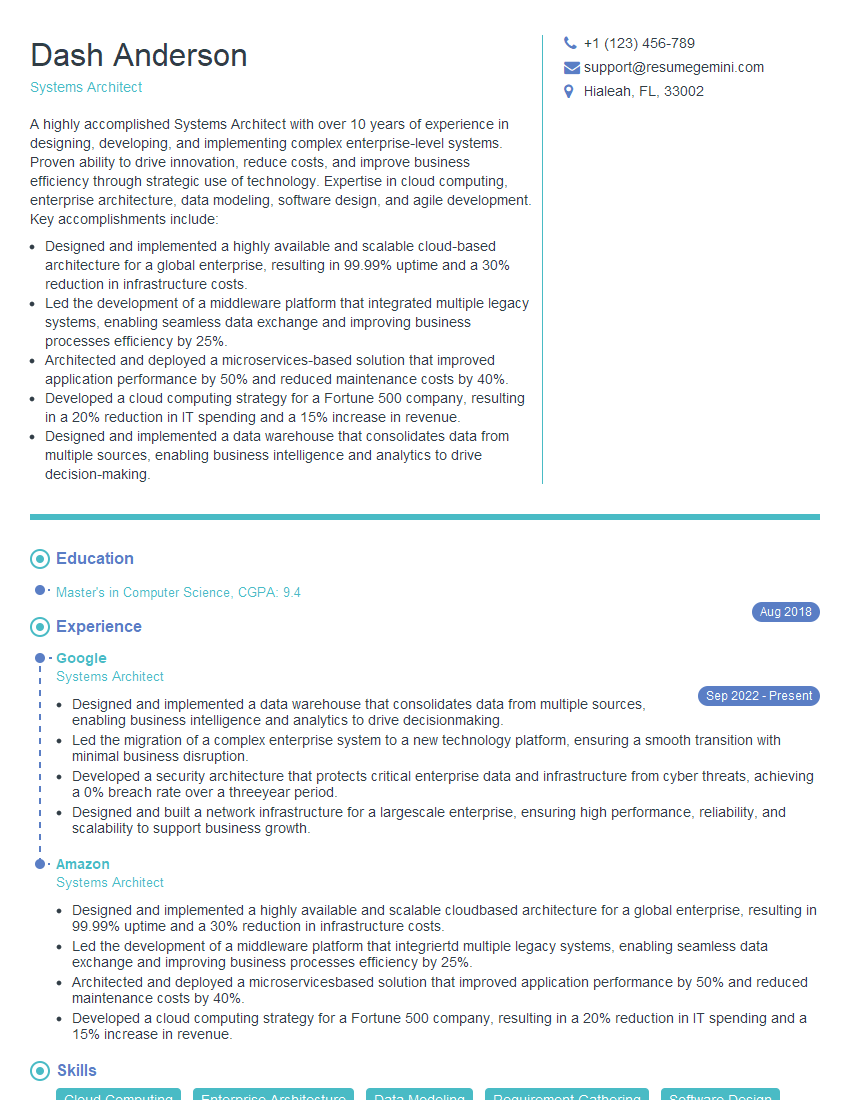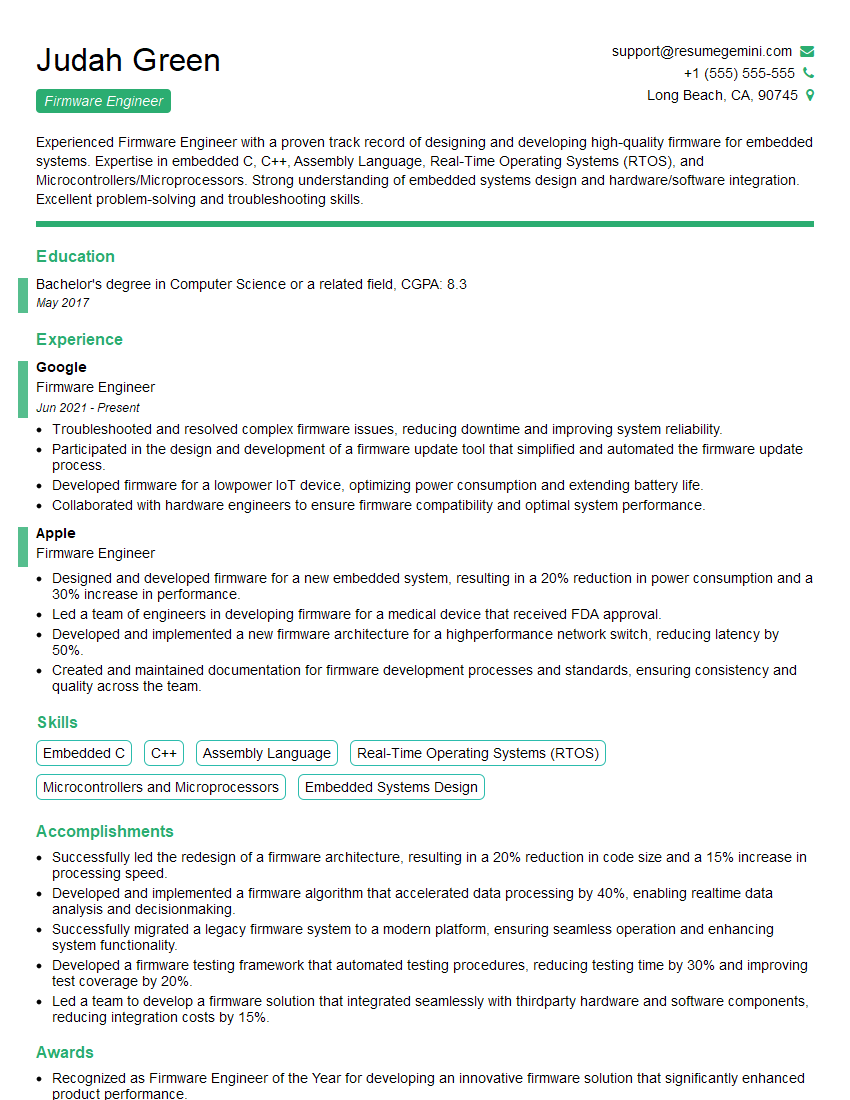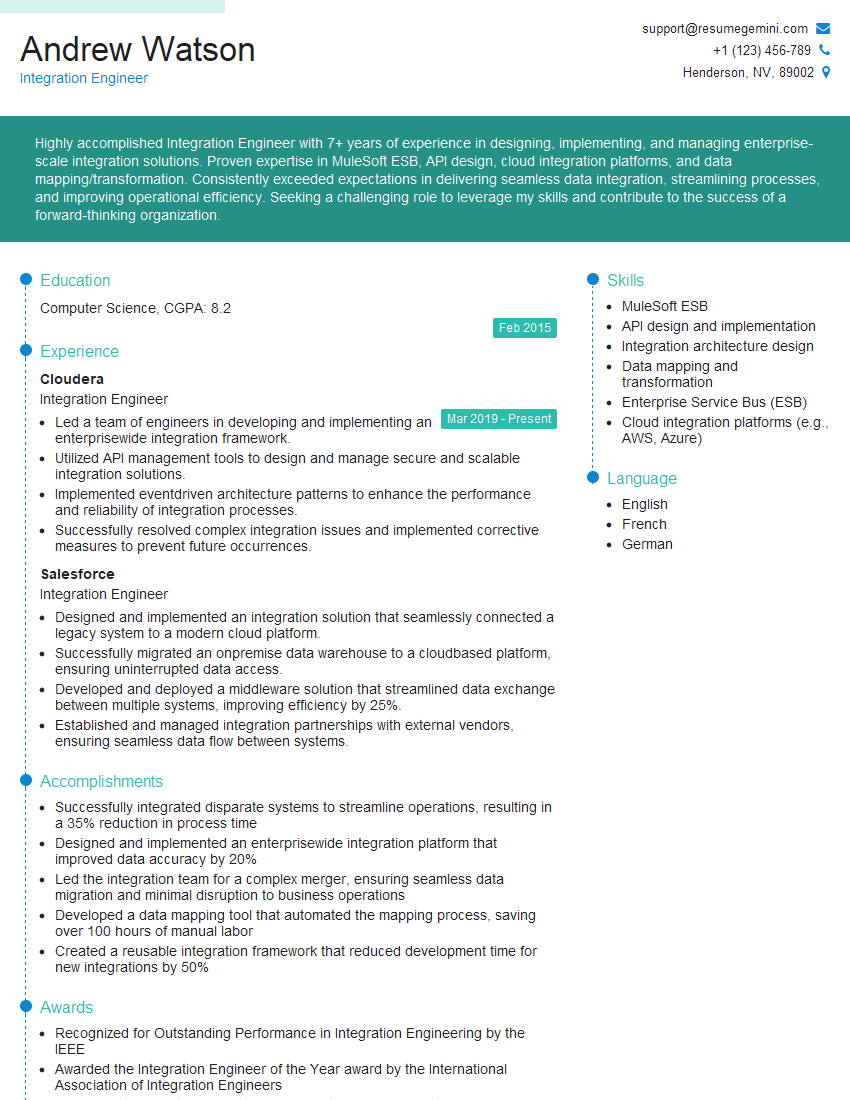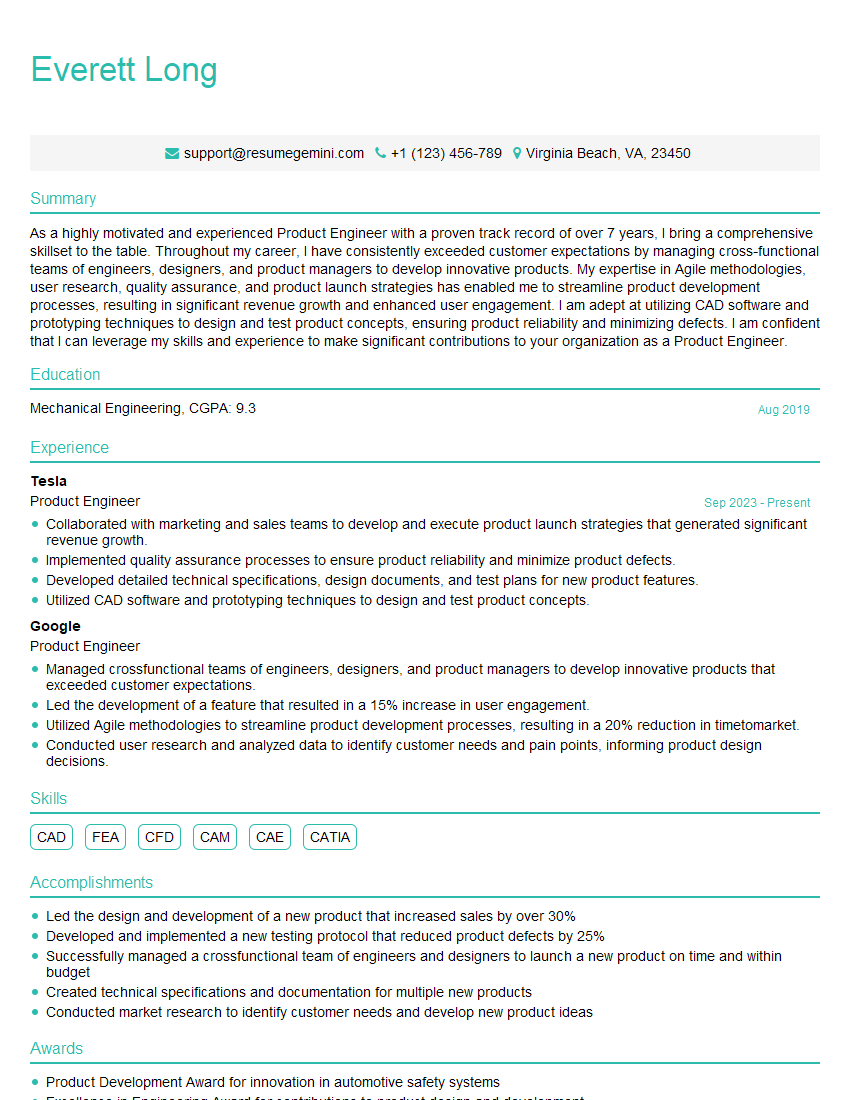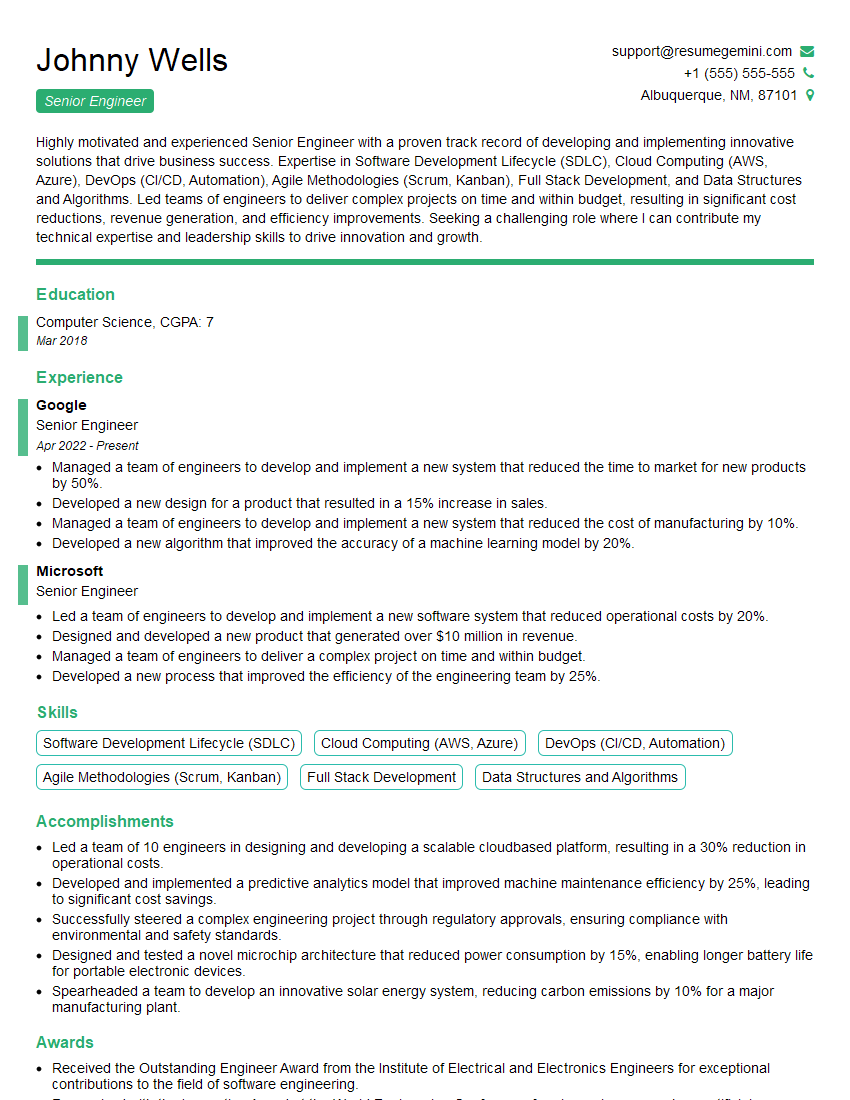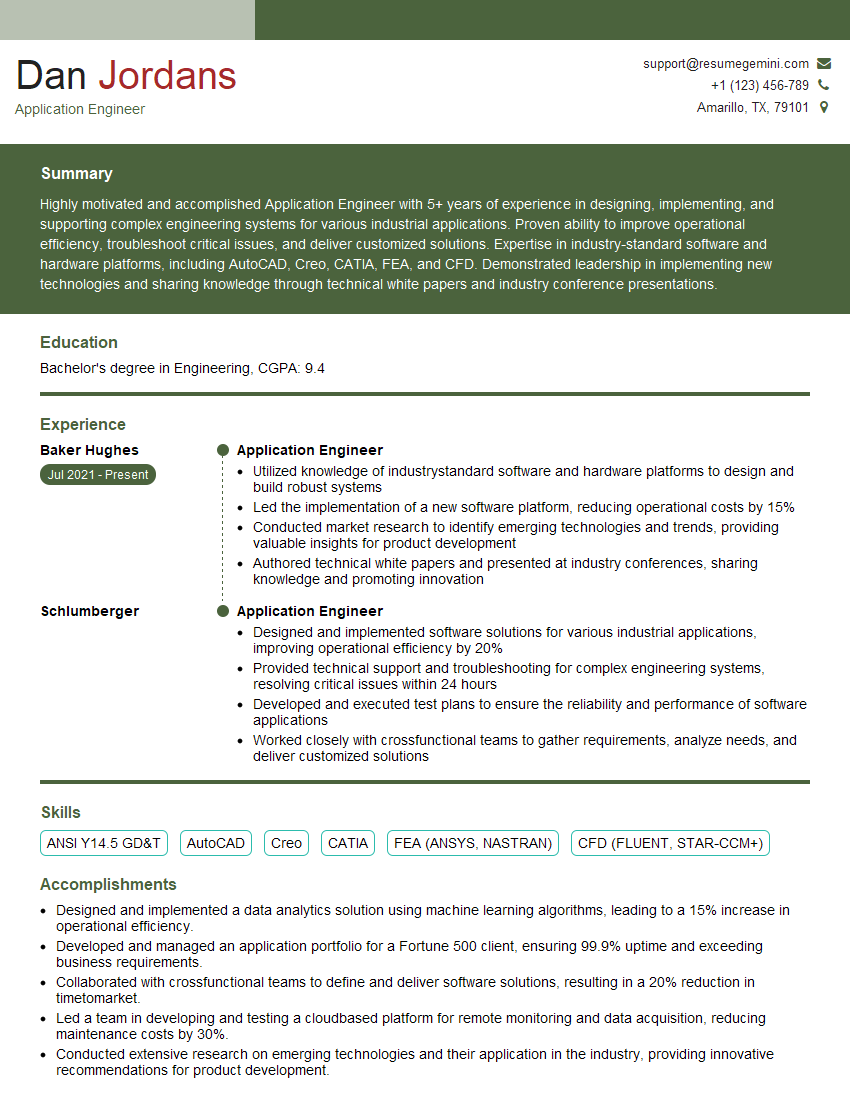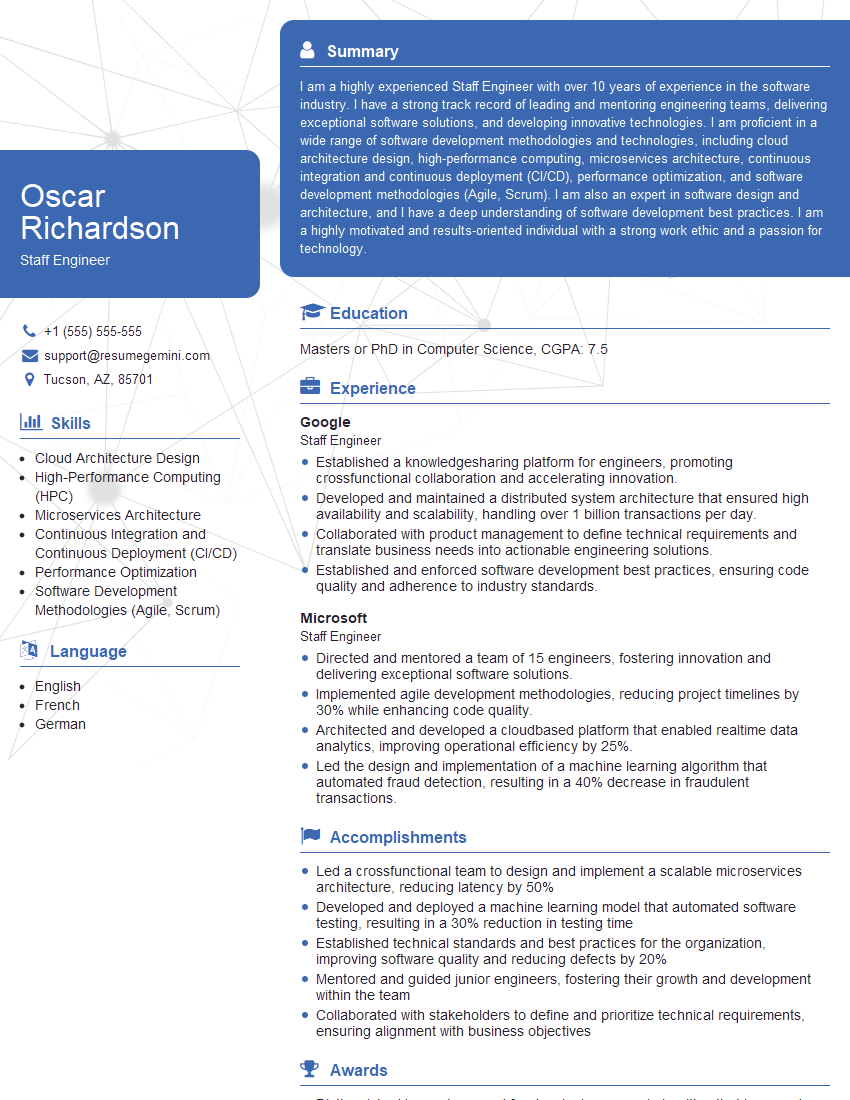Unlock your full potential by mastering the most common Communication Protocols (UART, RS-232, I/O Link) interview questions. This blog offers a deep dive into the critical topics, ensuring you’re not only prepared to answer but to excel. With these insights, you’ll approach your interview with clarity and confidence.
Questions Asked in Communication Protocols (UART, RS-232, I/O Link) Interview
Q 1. Explain the difference between UART and RS-232.
UART (Universal Asynchronous Receiver/Transmitter) and RS-232 (Recommended Standard 232) are closely related but distinct concepts. UART is a communication protocol that defines how data is formatted and transmitted serially, bit by bit. Think of it as the language used to send messages. RS-232, on the other hand, is an electrical standard that specifies the voltage levels and signal characteristics for transmitting those messages over a physical wire. It’s the dialect, specifying how the ‘language’ is physically spoken. A UART circuit implements the UART protocol, while RS-232 defines the electrical interface that the UART will work with. You can have a UART communicating using other electrical standards besides RS-232.
Q 2. What are the advantages and disadvantages of using RS-232?
Advantages of RS-232:
- Simple and inexpensive: RS-232 is relatively simple to implement, requiring minimal hardware compared to other communication standards.
- Long distances (with limitations): With appropriate signal conditioning, RS-232 can transmit data over relatively long distances (up to 50 feet without significant signal degradation).
- Widely supported: Many devices have built-in RS-232 ports, making it easy to integrate into existing systems.
Disadvantages of RS-232:
- Slow data rates: Compared to modern standards, RS-232 data rates are relatively slow.
- Susceptible to noise: It is susceptible to electrical noise, which can corrupt data, especially over long distances.
- Limited distance: While it can be extended, the standard only guarantees short distances. Long-distance communication requires more complex and expensive solutions.
- Only point-to-point: RS-232 is typically used for point-to-point communication; extending it to multiple devices requires additional hardware (e.g., multi-drop lines with repeaters).
Q 3. Describe the UART communication process, including data framing and error detection.
The UART communication process involves transmitting data serially, one bit at a time. The process usually consists of these steps:
- Data Framing: Each byte of data is framed with start and stop bits. The start bit signals the beginning of a byte, and the stop bit signals the end. Parity bits may also be included for error detection.
- Start Bit: A single logic low bit signals the beginning of a character transmission.
- Data Bits: 7 or 8 bits representing the data character are sent.
- Parity Bit (Optional): An additional bit used for error checking (discussed later).
- Stop Bit: One or more logic high bits signify the end of the data character.
Example Data Frame (8 data bits, 1 stop bit, no parity):
10110011 1Error Detection: Parity is a common technique. Even parity means that the total number of 1s in the frame (including the parity bit) must be even. Odd parity requires an odd number of 1s. If the receiver counts the 1s and the count is incorrect, an error is detected. Other error checking methods, like checksums or CRC (Cyclic Redundancy Check), could be used but are less common in simple UART applications.
Q 4. How does flow control work in RS-232 communication?
Flow control in RS-232 manages the rate of data transmission to prevent data loss when the receiving device can’t process data as fast as it’s being sent. Two common methods are:
- Hardware flow control: Uses dedicated control lines (RTS/CTS – Request To Send/Clear To Send, DTR/DSR – Data Terminal Ready/Data Set Ready). The sender checks the CTS line before sending data; if it’s low, the sender pauses. The receiver asserts CTS high when it’s ready to receive more.
- Software flow control: Uses special characters (XON/XOFF – Control-Q/Control-S) embedded in the data stream. The receiver sends XOFF to pause transmission and XON to resume. This is simpler to implement but can be less efficient for high data rates.
Imagine a water pipe. Hardware flow control is like having a valve at both ends – the sender only sends if the receiver’s valve is open. Software flow control is like sending a message: “Stop! I’m full” and “Resume sending” when the receiver is ready.
Q 5. What are the different baud rates commonly used in UART communication?
Common baud rates for UART communication include:
- 300 bps
- 1200 bps
- 2400 bps
- 4800 bps
- 9600 bps
- 19200 bps
- 38400 bps
- 57600 bps
- 115200 bps
The choice of baud rate depends on the application. Higher baud rates allow faster data transfer but require more precise timing and can be more susceptible to noise. Slower rates are more reliable at longer distances or with less-precise hardware.
Q 6. Explain the concept of parity bits in serial communication.
Parity bits are added to serial data for error detection. They are a simple form of redundancy. The parity bit is set (to 1 or 0) to ensure that the total number of 1s in the data byte (including the parity bit) is either even (even parity) or odd (odd parity). If a bit flips during transmission, the parity check will fail, alerting the receiver to a potential error. Note that it only detects single-bit errors; multiple errors can go undetected.
Example:
Data byte: 10110100 (four 1s)
Even parity: 101101001 (five 1s, now an odd number of 1s)
Odd parity: 101101000 (four 1s, maintaining an even number of 1s)
Q 7. What is the role of a UART transceiver?
A UART transceiver is a circuit that converts the parallel data from a microcontroller or computer (typically 8 bits) into serial data for transmission over a serial interface like RS-232. It also performs the reverse, converting incoming serial data into parallel data. Essentially, it bridges the gap between the parallel world of computers and the serial world of communication links. It handles the timing, start/stop bits, and parity as per the UART protocol. Furthermore, a UART transceiver frequently includes voltage level conversion, crucial when dealing with the different voltage levels used in RS-232 compared to TTL-level logic common in microcontrollers.
Q 8. How do you troubleshoot communication errors in a UART-based system?
Troubleshooting UART communication errors involves a systematic approach. Think of it like detective work – you need to gather clues to pinpoint the problem. First, verify the basic hardware connections: are the TX (transmit) and RX (receive) lines correctly connected between the communicating devices? Check for loose connections, incorrect wiring, or damaged cables. Next, confirm the baud rate settings match exactly on both ends; even a minor discrepancy will prevent communication. Use a logic analyzer or oscilloscope to visually inspect the signals on the TX and RX lines for any obvious anomalies like missing signals, noise, or incorrect voltage levels. Software-wise, inspect your code for errors in data formatting, parity settings, or flow control mechanisms. Finally, consider factors like noise interference – are other devices or power lines potentially causing signal corruption? A common strategy is to use a loopback test, where you connect the TX and RX lines together on one device and check for proper transmission and reception of data; this isolates issues in the transmitter and receiver circuits from external wiring problems. Remember to always check the power supply to both devices – insufficient power can lead to erratic behavior.
Q 9. What are the common RS-232 signal levels?
RS-232 defines signal levels using voltage ranges. Traditionally, a logic ‘1’ (high) is represented by a voltage between -3V and -15V, while a logic ‘0’ (low) is represented by a voltage between +3V and +15V. These voltage ranges help ensure robust signal transmission, minimizing the impact of noise. However, it’s important to note that these are merely the recommended voltage ranges, and the actual voltage levels can vary depending on the device and implementation. In practice, you might find variations within those ranges, but the key distinction remains the polarity: negative for a ‘1’ and positive for a ‘0’.
Q 10. Describe the signal characteristics of RS-232.
RS-232 signals are characterized by their voltage levels (as discussed), their asynchronous nature, and their use of a single-ended signal transmission (meaning each signal line has a single wire, referencing ground). This is different from differential signaling where a signal is transmitted using two wires, and the difference in voltage between those two wires is the relevant data. The asynchronous nature means that data is sent without a synchronized clock signal; instead, start and stop bits frame each byte of data. This method is relatively simple to implement but suffers from potential timing issues and the inability to transmit high-speed data efficiently. Because RS-232 is single-ended, it’s susceptible to noise interference; its long signal lines are more vulnerable to voltage fluctuations or electrical noise than differential signalling. Also, the maximum transmission speed is limited by the signal’s characteristics and the length of the cable.
Q 11. What are the maximum cable lengths for RS-232 communication?
The maximum cable length for RS-232 is highly dependent on several factors. The standard specifies only the voltage levels, not the maximum cable length. In practice, the signal integrity degrades significantly with increased cable length, as the signal attenuates. In ideal noise-free conditions, you could potentially reach 50 feet (15 meters). However, with increased cable length, noise susceptibility also goes up, leading to unreliable data transmission. To extend the range, you can use RS-232 signal boosters or repeaters, effectively regenerating the signal, but it adds complexity to your system.
Often, cable length is a practical rather than a theoretical limit. The data rate required and the level of noise immunity required both significantly impact the maximum practical cable length. For reliable data communication, it’s recommended to keep the cable as short as possible. A good rule of thumb is to aim for lengths below 50 feet, especially in electrically noisy environments.
Q 12. What is I/O Link and what are its advantages over traditional fieldbus systems?
I/O-Link is a point-to-point communication standard for industrial sensors and actuators. Think of it as a sophisticated upgrade to simple digital I/O, offering bidirectional communication, power supply, and enhanced diagnostic capabilities. Compared to traditional fieldbus systems like Profibus or Profinet, I/O-Link provides several advantages: It’s simpler to implement, less expensive, and easier to troubleshoot. It uses a standard three-wire connection (power, data in, data out), reducing wiring complexity and cost. The point-to-point communication allows for direct device addressing without the complexity of a fieldbus network topology. Diagnostic data directly from the connected devices is easily accessible, providing invaluable information for predictive maintenance. The ability to manage a wide range of devices (both digital and analog sensors and actuators) allows for scalability in a manufacturing environment.
Q 13. Explain the different I/O Link communication modes.
I/O-Link supports two main communication modes: 3600 baud rate mode for standard communication and 26250 baud rate mode for high speed data communication. The standard mode is ideal for basic sensor and actuator communication, transmitting relatively small amounts of data. The high-speed mode is suitable for applications requiring high data throughput, such as high-resolution sensors that output a continuous stream of data or actuators requiring frequent parameter updates. The choice of mode depends entirely on the requirements of the application; if you only need simple on/off commands, the standard mode would suffice. If real-time data acquisition and control are critical, then the high-speed mode is preferred. The selection is usually configured via the I/O-Link master device.
Q 14. How does I/O Link handle data transmission and error detection?
I/O-Link employs a robust mechanism for data transmission and error detection. Data is transmitted using a cyclical communication pattern, allowing for regular data updates. Error detection is crucial. I/O-Link uses a cyclic redundancy check (CRC) mechanism to ensure data integrity. The CRC checksum is calculated during the data transmission process. Both the sender and the receiver independently calculate this checksum. If the checksums don’t match, an error is detected. In case of an error, the I/O-Link master can initiate retransmission or trigger an error notification. This provides a reliable method of ensuring that the data received is indeed the same data that was sent. The error-handling mechanism is transparent to the user; the master device handles the retransmissions or error reporting, providing a seamless user experience. Data is typically organized into I/O-Link messages containing various data fields relevant to the connected device. The structure of these messages is clearly defined by the I/O-Link standard.
Q 15. What are the key differences between I/O Link Master and I/O Link Device?
The key difference between an I/O-Link Master and an I/O-Link Device lies in their roles within the communication network. Think of it like a server and clients. The Master is the central controller, initiating communication and managing the entire I/O-Link network. It’s responsible for addressing, data acquisition, and power supply to the devices. The Device, on the other hand, is a sensor or actuator that passively responds to requests from the Master, sending and receiving data as instructed. The Master acts as the central hub, whereas the Devices are the peripheral components reporting data or receiving commands.
- Master: Initiates communication, assigns addresses, supplies power, reads and writes data.
- Device: Responds to commands, sends data as requested, receives power from the Master.
For example, in a factory automation setting, a Programmable Logic Controller (PLC) acting as the I/O-Link Master would communicate with numerous I/O-Link Devices like temperature sensors, proximity sensors, and valves. The PLC would poll these devices for readings, and based on the data, it might actuate the valves.
Career Expert Tips:
- Ace those interviews! Prepare effectively by reviewing the Top 50 Most Common Interview Questions on ResumeGemini.
- Navigate your job search with confidence! Explore a wide range of Career Tips on ResumeGemini. Learn about common challenges and recommendations to overcome them.
- Craft the perfect resume! Master the Art of Resume Writing with ResumeGemini’s guide. Showcase your unique qualifications and achievements effectively.
- Don’t miss out on holiday savings! Build your dream resume with ResumeGemini’s ATS optimized templates.
Q 16. Describe the physical layer of I/O Link.
The physical layer of I/O-Link utilizes a standard 3-wire connection: two wires for data communication (using a low-voltage, current-based signaling), and one wire for power supply. This simple setup allows for easy integration into existing industrial automation systems. It’s usually a shielded twisted pair cable for better noise immunity. The communication is based on a robust, low-power, serial protocol that can operate over distances of up to 20 meters without needing any special repeaters or line drivers. This is quite remarkable for its simplicity and robustness compared to more complex protocols.
The connection often utilizes standard M5 or M8 connectors, making it easily adaptable to various industrial environments and sensors. This ease of integration is a key factor in I/O-Link’s widespread adoption.
Q 17. How do you configure an I/O Link master?
Configuring an I/O-Link Master involves several steps, primarily through the software interface of the master device (often a PLC or dedicated I/O-Link master module). This varies depending on the specific master device and software but generally follows this pattern:
- Physical Connection: Connect the I/O-Link master to the network and the I/O-Link devices using the appropriate cables and connectors.
- Software Configuration: Access the master’s configuration software, usually via a programming environment or dedicated software interface. This involves configuring the communication parameters (baud rate, data format, etc.).
- Device Detection: The Master will typically automatically detect connected I/O-Link devices. Some Masters require manual device addition.
- Addressing: Assign unique addresses to each I/O-Link device. This is crucial for the Master to identify and communicate with each device individually.
- Parameterization: Configure the parameters of individual I/O-Link devices. This often includes setting measurement ranges, thresholds, and other device-specific settings. Many devices offer a self-describing profile, simplifying this step.
- Testing and Validation: Test the communication and functionality of the configured I/O-Link network by checking data transfer and device responses.
The process usually involves a combination of hardware connections, software configuration within the PLC or master’s programming environment and potentially using the master’s integrated diagnostics.
Q 18. What are the different types of I/O Link sensors and actuators?
I/O-Link supports a wide variety of sensor and actuator types, offering a versatile solution for diverse applications. Some common examples include:
- Sensors: Analog sensors (temperature, pressure, etc.), digital sensors (proximity, photoelectric, etc.), binary sensors (limit switches), and even more complex sensors integrating various data types.
- Actuators: Valves (solenoids, pneumatic, etc.), motors, and other controllable devices.
The versatility stems from I/O-Link’s ability to handle both digital and analog signals, making it a unified communication standard for a large range of devices. This reduces the number of different communication interfaces needed in a system.
For example, a manufacturing process might use I/O-Link temperature sensors to monitor the temperature of a production line, proximity sensors to detect product presence, and valves to control fluid flow. All these devices can be managed through a single I/O-Link Master, simplifying system design and maintenance.
Q 19. How can you diagnose I/O Link communication problems?
Diagnosing I/O-Link communication problems involves a systematic approach:
- Check Physical Connections: Ensure all cables are properly connected and not damaged. Look for loose connections or broken wires.
- Verify Power Supply: Confirm that the I/O-Link Master is supplying sufficient power to the devices. Check the voltage at the devices’ power pins.
- Inspect LEDs: Most I/O-Link devices have LEDs indicating power, communication status, and potential errors. Examine these LEDs for clues about the issue.
- Use Diagnostic Tools: I/O-Link Masters usually provide diagnostic tools within their software interfaces. These tools can display communication errors, signal quality, and device status information.
- Check Addressing: Verify that each device has a unique address and that the addresses are correctly configured in the I/O-Link Master.
- Examine Communication Parameters: Make sure the baud rate and other communication settings are properly configured and match between the Master and Devices.
- Cable Testing: In some cases, it is beneficial to test the cable for continuity and proper shielding.
Systematic troubleshooting, starting with the simplest checks and moving towards more advanced diagnostics, allows for effective identification and resolution of I/O-Link problems. Remember to consult the device and Master manuals for specific troubleshooting information.
Q 20. Explain the concept of addressing in I/O Link.
Addressing in I/O-Link is crucial for the Master to identify individual devices within the network. Each I/O-Link device is assigned a unique address, typically a numerical value. This address allows the Master to specifically target a particular device when sending commands or requesting data. Addresses can be assigned automatically by the Master during device detection, or manually by the user through the Master’s configuration software. The addressing scheme simplifies communication management and allows for individual control over numerous devices.
For example, consider a scenario with three temperature sensors. Each sensor would have its own unique address, say 1, 2, and 3. The Master can then address each sensor individually to read its temperature value. This prevents conflicts and allows for precise control of each device.
Q 21. How does I/O Link support power supply to connected devices?
I/O-Link provides power to connected devices through the same three-wire connection used for communication. The power supply is integrated into the communication protocol, making it a highly efficient system. The Master supplies power over one of the wires, and the devices receive power and communicate data over the other two wires. This simplifies wiring and reduces the number of separate power supplies needed, making it more cost-effective and space-saving. The power supply voltage is typically 24 VDC.
The power supplied can range from a few milliamps for low-power devices, to several hundred milliamps for more power-hungry devices depending on the Master’s capabilities. The master’s configuration software usually allows for managing power distribution to devices on the network.
Q 22. Compare and contrast UART, RS-232, and I/O Link.
UART, RS-232, and I/O Link are all serial communication protocols, but they differ significantly in their features, applications, and physical layers. Think of them as different ways to send messages—some are suited for short, simple notes, while others handle complex packages.
- UART (Universal Asynchronous Receiver/Transmitter): This is a basic, widely used protocol for transmitting data serially bit by bit. It’s asynchronous, meaning it doesn’t need a clock signal synchronized between sender and receiver. It’s simple, inexpensive, and readily available in microcontrollers. However, it’s limited in distance and speed.
- RS-232 (Recommended Standard 232): RS-232 is a standard defining the electrical characteristics of a serial communication interface. It uses voltage levels to represent data (typically ±12V), allowing for longer distances than UART. It’s commonly used for connecting computers to peripherals like modems or older instruments. However, it’s relatively slow and susceptible to noise, particularly over longer distances.
- I/O Link: This is a digital communication protocol designed specifically for industrial automation. It provides a standardized way for sensors and actuators to communicate with PLCs (Programmable Logic Controllers) over a single twisted-pair cable. I/O Link offers advantages like power supply over the same cable (PoL), simplified wiring, and increased data rates compared to traditional sensor interfaces. It’s also robust and immune to many environmental interferences found in factory settings.
In short: UART is simple and ubiquitous; RS-232 extends the distance, but suffers from noise; I/O Link is designed for industrial automation, offering power and data over a single cable with robust performance.
Q 23. What are the applications of UART, RS-232, and I/O Link?
The applications of these protocols are diverse and largely determined by their characteristics:
- UART: Commonly found in embedded systems, microcontrollers, and simple data exchange between devices. Examples include communication with GPS modules, Bluetooth modules, or simple sensor interfaces.
- RS-232: Historically used for connecting modems, older printers, and other computer peripherals. While less common today, it persists in some legacy systems and specialized applications.
- I/O Link: Primarily used in industrial automation for connecting sensors and actuators to PLCs. This could include temperature sensors, pressure sensors, proximity sensors, and various actuators in manufacturing processes.
Imagine a home automation system using UART to communicate with individual devices. A large industrial plant might employ RS-232 in older equipment while relying on I/O-Link for modern sensor integration.
Q 24. How do you choose the appropriate communication protocol for a specific application?
Choosing the right communication protocol depends on several factors. It’s a trade-off between various requirements.
- Distance: For short distances, UART is sufficient. RS-232 handles longer distances, while I/O-Link is usually limited to a few hundred meters.
- Speed: UART and RS-232 can be slow compared to I/O-Link, which offers better data rates for real-time applications.
- Cost: UART is generally the least expensive option, followed by RS-232. I/O-Link can have higher initial costs but reduces wiring complexity.
- Noise Immunity: RS-232 and I/O-Link offer better noise immunity than UART. I/O-Link is especially robust.
- Power Consumption: I/O-Link’s power over line feature reduces wiring and power supply complexity.
- Application Requirements: The nature of the application dictates the necessary speed, reliability, and data volume.
For example, a simple temperature sensor on a small embedded device might use UART. A long-distance connection to a remote sensor in a harsh environment would likely need RS-485 (a differential variant of RS-232 offering better noise immunity) or I/O-Link. A high-speed industrial automation setting demanding real-time data would favor I/O-Link.
Q 25. Describe a scenario where you had to troubleshoot a communication problem. What was the root cause, and how did you resolve it?
I once encountered intermittent communication failures between a PLC and a temperature sensor using RS-485. The sensor would occasionally report incorrect readings, or no data at all.
My troubleshooting steps included:
- Visual Inspection: Checked the wiring for any loose connections or damaged cables.
- Signal Tracing: Used an oscilloscope to observe the RS-485 signals at various points in the circuit. This revealed significant noise interference at certain times.
- Environmental Analysis: Noticed the sensor was located near high-power motors, which likely caused the electromagnetic interference (EMI).
- Solution Implementation: We shielded the RS-485 cable, installed common-mode chokes to filter out noise, and relocated the cable away from the motors. This significantly reduced the EMI, resolving the communication problem.
The root cause was EMI from nearby motors affecting the RS-485 signal. Shielding and filtering solved the issue, highlighting the importance of considering environmental factors when designing communication systems.
Q 26. Explain your experience with different communication protocol standards.
My experience spans various communication protocols, including UART, RS-232, RS-485, I/O-Link, CAN, and Modbus. I’ve worked with these protocols in a range of applications, from embedded systems development to industrial automation projects. This includes hands-on experience with configuring communication parameters, troubleshooting signal integrity problems, and integrating different devices onto a single communication bus. I am proficient in using diagnostic tools like oscilloscopes and protocol analyzers to identify and resolve communication issues.
For example, in one project, I integrated a variety of sensors (using I/O-Link) and actuators (using Modbus) to a central PLC system, carefully managing the timing and data flow to ensure real-time control.
Q 27. What are your strengths and weaknesses in working with communication protocols?
Strengths: My key strengths are my deep understanding of the underlying principles of various communication protocols, my practical experience in troubleshooting complex communication systems, and my ability to adapt to different communication standards. I excel at integrating diverse communication technologies into a coherent system. I also possess strong problem-solving skills, evidenced by my ability to pinpoint and rectify challenging communication problems systematically.
Weaknesses: While I am highly proficient in many protocols, staying completely current with the newest and niche protocols emerging constantly is a continuous learning process. I actively work on mitigating this by reading relevant literature, attending workshops, and engaging in professional networking.
Key Topics to Learn for Communication Protocols (UART, RS-232, I/O Link) Interview
- UART (Universal Asynchronous Receiver/Transmitter):
- Serial communication basics: bit rate, baud rate, start/stop bits, parity.
- Hardware implementation: Understanding UART registers and control signals.
- Software implementation: Familiarize yourself with UART driver functions and APIs.
- Error detection and handling mechanisms.
- Practical application: Data logging, simple sensor interfacing.
- RS-232:
- Voltage levels and signal standards.
- Interface circuits and level conversion (e.g., MAX232).
- Cable considerations: distance limitations and noise immunity.
- Troubleshooting common RS-232 issues (e.g., signal integrity problems).
- Practical application: Connecting to legacy devices, industrial control systems.
- I/O Link:
- Master/slave communication model.
- Data transmission speeds and data types.
- Advantages over traditional I/O communication methods.
- Understanding I/O Link’s role in Industry 4.0.
- Practical application: Sensor integration in automated systems, process control.
- Comparative Analysis:
- Strengths and weaknesses of each protocol.
- Choosing the appropriate protocol for a given application.
- Troubleshooting and Problem Solving:
- Developing systematic approaches to diagnosing communication errors.
- Using diagnostic tools and techniques (e.g., oscilloscopes, logic analyzers).
Next Steps
Mastering Communication Protocols like UART, RS-232, and I/O Link is crucial for advancing your career in embedded systems, industrial automation, and related fields. These skills are highly sought after by employers. To maximize your job prospects, focus on creating an ATS-friendly resume that highlights your expertise. ResumeGemini is a trusted resource that can help you build a professional resume that showcases your abilities effectively. Examples of resumes tailored to Communication Protocols (UART, RS-232, I/O Link) are available to help guide you.
Explore more articles
Users Rating of Our Blogs
Share Your Experience
We value your feedback! Please rate our content and share your thoughts (optional).
What Readers Say About Our Blog
Hello,
We found issues with your domain’s email setup that may be sending your messages to spam or blocking them completely. InboxShield Mini shows you how to fix it in minutes — no tech skills required.
Scan your domain now for details: https://inboxshield-mini.com/
— Adam @ InboxShield Mini
Reply STOP to unsubscribe
Hi, are you owner of interviewgemini.com? What if I told you I could help you find extra time in your schedule, reconnect with leads you didn’t even realize you missed, and bring in more “I want to work with you” conversations, without increasing your ad spend or hiring a full-time employee?
All with a flexible, budget-friendly service that could easily pay for itself. Sounds good?
Would it be nice to jump on a quick 10-minute call so I can show you exactly how we make this work?
Best,
Hapei
Marketing Director
Hey, I know you’re the owner of interviewgemini.com. I’ll be quick.
Fundraising for your business is tough and time-consuming. We make it easier by guaranteeing two private investor meetings each month, for six months. No demos, no pitch events – just direct introductions to active investors matched to your startup.
If youR17;re raising, this could help you build real momentum. Want me to send more info?
Hi, I represent an SEO company that specialises in getting you AI citations and higher rankings on Google. I’d like to offer you a 100% free SEO audit for your website. Would you be interested?
Hi, I represent an SEO company that specialises in getting you AI citations and higher rankings on Google. I’d like to offer you a 100% free SEO audit for your website. Would you be interested?
good


